Opinion & Analysis
Top 5 wedges of all time
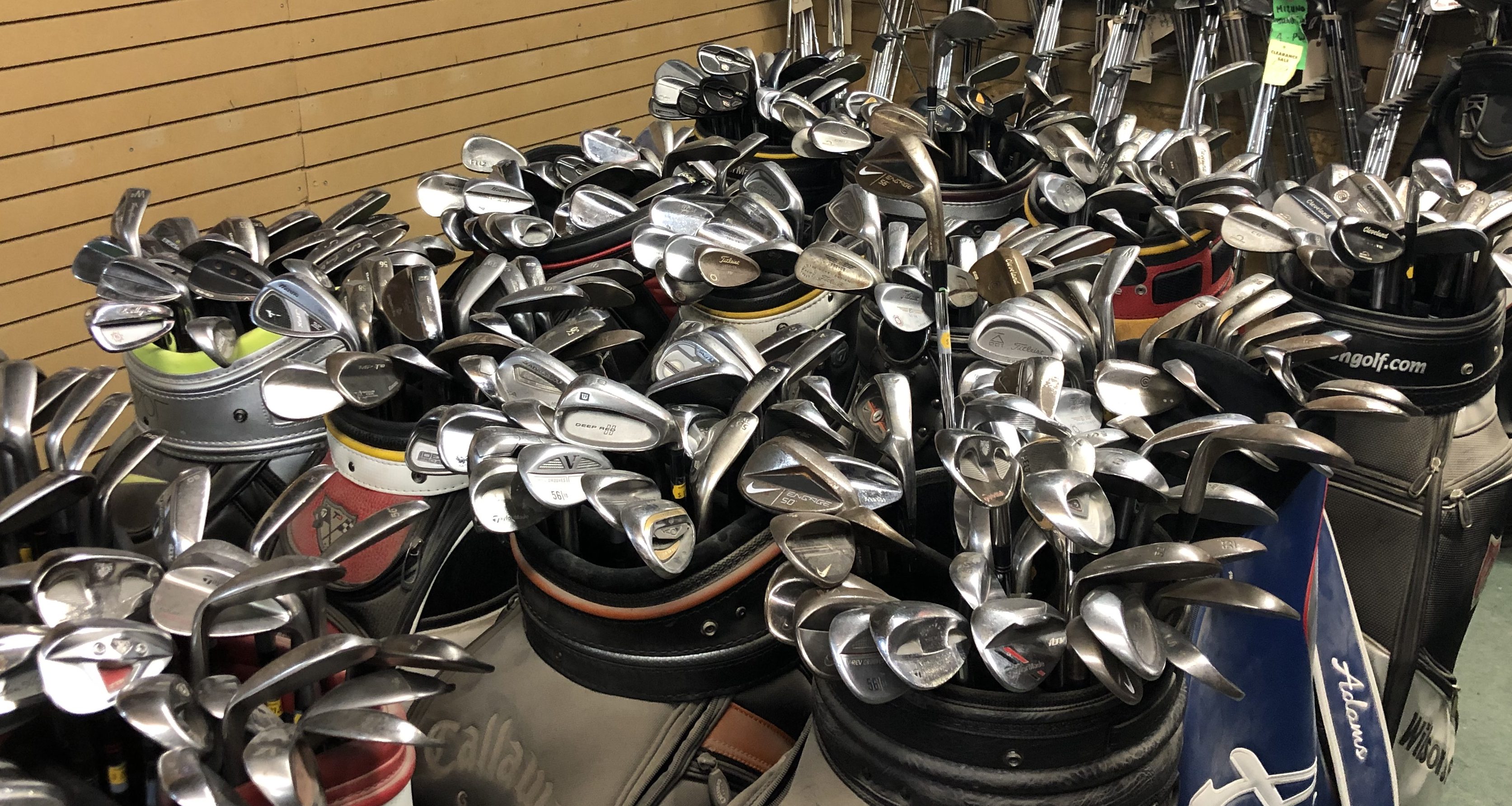
Wedges. They are the “trusted old friends” in our golf bags. They inspire confidence inside of 100 yards and help us get back on track when we hit a wayward approach.
There was a time not too long ago when a bunker was considered a true hazard, but over the last 80 years, as agronomy has evolved on the same trajectory as club an ball technology, wedges have changed a great deal along the way—from the first modern prototype wedge built by Gene Sarazen to clubs featuring various plating and coatings to increase spin and performance. There are a lot of wedge designs that have stood the test of time; their sole grinds, profiles from address, and performance bring back memories of great hole outs and recovery shots.
With so many variations of wedges in the history of golf (and so much parity), this is my top five list (in no particular order) of the most iconic wedges in golf history.
Original Gene Sarazen Wedge
Gene is famous for a lot of things: the career grand slam, the longest endorsement deal in professional sports history (75 years as a Wilson ambassador), the “shot heard around the world”, and as mentioned earlier—the creation of the modern sand wedge. Although not credited with the invention of the original “sand wedge” he 100 percent created the modern wedge with a steel shaft and higher bounce. A creation that developed from soldering mass to the sole and flange of what would be our modern-day pitching wedge. Born from the idea of a plane wing, thanks to a trip taken with Howard Hughes, we can all thank Mr. Sarazen for the help with the short shots around the green.
Wilson R90
The next evolution of the original Sarazen Design, the Wilson R90 was the very first mass-marketed sand wedge. Its design characteristics can still be seen in the profile of some modern wedges. Although many might not be as familiar with the R90, you would almost certainly recognize the shape, since it was very often copied by other manufacturers, in their wedge lines.
The R90 features a very rounded profile, high amount of offset, and a great deal of bounce in the middle of the sole, with very little camber. Although not as versatile as modern wedges because of the reduced curve from heel to toe, the R90 is still a force to be reckoned with in the sand.
Cleveland 588
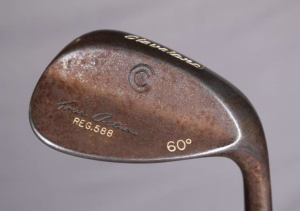
You know a name and design are classic when a company chooses to use the original notation more than 30 years after its initial release. The 588 was introduced as Cleveland’s fifth wedge design and came to market in 1988—which is how it got its name. Wedges were never the same after.
The brainchild of Roger Cleveland, the 588 was made from 8620 carbon steel—which patinad over time. Not unlike the Wilson before it, the 588 had a very traditional rounded shape with a higher toe and round leading edge. The other part of the design that created such versatility was the V-Sole (No, not the same as the Current Srixon), that offers a lot more heel relief to lower the leading edge as the face was opened up—this was the birth of the modern wedge grind.
Titleist Vokey Spin Milled
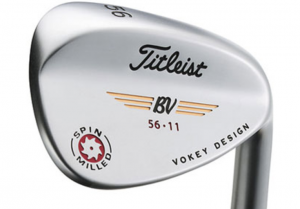
The wedge that launched the Vokey brand into the stratosphere. Spin-milled faces changed the way golfers look at face technology in their scoring clubs. From a humble club builder to a wedge guru, Bob Vokey has been around golf and the short game for a long time. The crazy thing about the Bob Vokey story is that it all started with one question: “who wants to lead the wedge team?” That was all it took to get him from shaping Titleist woods to working with the world’s best players to create high-performance short game tools.
Honorable mentions for design goes to the first 200 and 400 series wedge, which caught golfers’ eyes with their teardrop shape—much like the Cleveland 588 before it.
Ping Eye 2 Plus
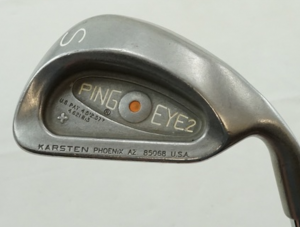
What can you say? The unique wedge design that other OEMs continue to draw inspiration from it 30 years after its original conception. The Eye 2+ wedge was spawned from what is undoubtedly the most popular iron design of all time, which went through many iterations during its 10 years on the market—a lifecycle that is completely unheard of in today’s world of modern equipment.
A pre-worn sole, huge amount of heel and toe radius, and a face that screams “you can’t miss,” the true beauty comes from the way the hosel transitions into the head, which makes the club one of the most versatile of all time.
Check out my video below for more on why this wedge was so great.
Honorable mention: The Alien wedge
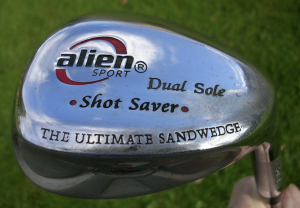
To this day, the Alien wedge is the number-one-selling single golf club of all time! Although I’m sure there aren’t a lot of people willing to admit to owning one, it did help a lot of golfer by simplifying the short game, especially bunker shots.
Its huge profile looked unorthodox, but by golly did it ever work! Designed to be played straight face and essentially slammed into the sand to help elevate the ball, the club did what it set out to do: get you out of the sand on the first try. You could say that it was inspired by the original Hogan “Sure-Out,” but along the way it has also inspired others to take up the baton in helping the regular high-handicap golfer get out of the sand—I’m looking at you XE1.
That’s my list, WRXers. What would you add? Let me know in the comments!
- LIKE331
- LEGIT36
- WOW14
- LOL10
- IDHT5
- FLOP8
- OB6
- SHANK72
19th Hole
Vincenzi’s 2024 Zurich Classic of New Orleans betting preview

The PGA TOUR heads to New Orleans to play the 2023 Zurich Classic of New Orleans. In a welcome change from the usual stroke play, the Zurich Classic is a team event. On Thursday and Saturday, the teams play best ball, and on Friday and Sunday the teams play alternate shot.
TPC Louisiana is a par 72 that measures 7,425 yards. The course features some short par 4s and plenty of water and bunkers, which makes for a lot of exciting risk/reward scenarios for competitors. Pete Dye designed the course in 2004 specifically for the Zurich Classic, although the event didn’t make its debut until 2007 because of Hurricane Katrina.
Coming off of the Masters and a signature event in consecutive weeks, the field this week is a step down, and understandably so. Many of the world’s top players will be using this time to rest after a busy stretch.
However, there are some interesting teams this season with some stars making surprise appearances in the team event. Some notable teams include Patrick Cantlay and Xander Schauffele, Rory McIlroy and Shane Lowry, Collin Morikawa and Kurt Kitayama, Will Zalatoris and Sahith Theegala as well as a few Canadian teams, Nick Taylor and Adam Hadwin and Taylor Pendrith and Corey Conners.
Past Winners at TPC Louisiana
- 2023: Riley/Hardy (-30)
- 2022: Cantlay/Schauffele (-29)
- 2021: Leishman/Smith (-20)
- 2019: Palmer/Rahm (-26)
- 2018: Horschel/Piercy (-22)
- 2017: Blixt/Smith (-27)
2024 Zurich Classic of New Orleans Picks
Tom Hoge/Maverick McNealy +2500 (DraftKings)
Tom Hoge is coming off of a solid T18 finish at the RBC Heritage and finished T13 at last year’s Zurich Classic alongside Harris English.
This season, Hoge is having one of his best years on Tour in terms of Strokes Gained: Approach. In his last 24 rounds, the only player to top him on the category is Scottie Scheffler. Hoge has been solid on Pete Dye designs, ranking 28th in the field over his past 36 rounds.
McNealy is also having a solid season. He’s finished T6 at the Waste Management Phoenix Open and T9 at the PLAYERS Championship. He recently started working with world renowned swing coach, Butch Harmon, and its seemingly paid dividends in 2024.
Keith Mitchell/Joel Dahmen +4000 (DraftKings)
Keith Mitchell is having a fantastic season, finishing in the top-20 of five of his past seven starts on Tour. Most recently, Mitchell finished T14 at the Valero Texas Open and gained a whopping 6.0 strokes off the tee. He finished 6th at last year’s Zurich Classic.
Joel Dahmen is having a resurgent year and has been dialed in with his irons. He also has a T11 finish at the PLAYERS Championship at TPC Sawgrass which is another Pete Dye track. With Mitchell’s length and Dahmen’s ability to put it close with his short irons, the Mitchell/Dahmen combination will be dangerous this week.
Taylor Moore/Matt NeSmith +6500 (DraftKings)
Taylor Moore has quickly developed into one of the more consistent players on Tour. He’s finished in the top-20 in three of his past four starts, including a very impressive showing at The Masters, finishing T20. He’s also finished T4 at this event in consecutive seasons alongside Matt NeSmith.
NeSmith isn’t having a great 2024, but has seemed to elevate his game in this format. He finished T26 at Pete Dye’s TPC Sawgrass, which gives the 30-year-old something to build off of. NeSmith is also a great putter on Bermudagrass, which could help elevate Moore’s ball striking prowess.
- LIKE6
- LEGIT3
- WOW1
- LOL0
- IDHT0
- FLOP3
- OB1
- SHANK1
19th Hole
Vincenzi’s 2024 LIV Adelaide betting preview: Cam Smith ready for big week down under

After having four of the top twelve players on the leaderboard at The Masters, LIV Golf is set for their fifth event of the season: LIV Adelaide.
For both LIV fans and golf fans in Australia, LIV Adelaide is one of the most anticipated events of the year. With 35,000 people expected to attend each day of the tournament, the Grange Golf Club will be crawling with fans who are passionate about the sport of golf. The 12th hole, better known as “the watering hole”, is sure to have the rowdiest of the fans cheering after a long day of drinking some Leishman Lager.
The Grange Golf Club is a par-72 that measures 6,946 yards. The course features minimal resistance, as golfers went extremely low last season. In 2023, Talor Gooch shot consecutive rounds of 62 on Thursday and Friday, giving himself a gigantic cushion heading into championship Sunday. Things got tight for a while, but in the end, the Oklahoma State product was able to hold off The Crushers’ Anirban Lahiri for a three-shot victory.
The Four Aces won the team competition with the Range Goats finishing second.
*All Images Courtesy of LIV Golf*
Past Winners at LIV Adelaide
- 2023: Talor Gooch (-19)
Stat Leaders Through LIV Miami
Green in Regulation
- Richard Bland
- Jon Rahm
- Paul Casey
Fairways Hit
- Abraham Ancer
- Graeme McDowell
- Henrik Stenson
Driving Distance
- Bryson DeChambeau
- Joaquin Niemann
- Dean Burmester
Putting
- Cameron Smith
- Louis Oosthuizen
- Matt Jones
2024 LIV Adelaide Picks
Cameron Smith +1400 (DraftKings)
When I pulled up the odds for LIV Adelaide, I was more than a little surprised to see multiple golfers listed ahead of Cameron Smith on the betting board. A few starts ago, Cam finished runner-up at LIV Hong Kong, which is a golf course that absolutely suits his eye. Augusta National in another course that Smith could roll out of bed and finish in the top-ten at, and he did so two weeks ago at The Masters, finishing T6.
At Augusta, he gained strokes on the field on approach, off the tee (slightly), and of course, around the green and putting. Smith able to get in the mix at a major championship despite coming into the week feeling under the weather tells me that his game is once again rounding into form.
The Grange Golf Club is another course that undoubtedly suits the Australian. Smith is obviously incredibly comfortable playing in front of the Aussie faithful and has won three Australian PGA Championship’s. The course is very short and will allow Smith to play conservative off the tee, mitigating his most glaring weakness. With birdies available all over the golf course, there’s a chance the event turns into a putting contest, and there’s no one on the planet I’d rather have in one of those than Cam Smith.

Louis Oosthuizen +2200 (DraftKings)
Louis Oosthuizen has simply been one of the best players on LIV in the 2024 seas0n. The South African has finished in the top-10 on the LIV leaderboard in three of his five starts, with his best coming in Jeddah, where he finished T2. Perhaps more impressively, Oosthuizen finished T7 at LIV Miami, which took place at Doral’s “Blue Monster”, an absolutely massive golf course. Given that Louis is on the shorter side in terms of distance off the tee, his ability to play well in Miami shows how dialed he is with the irons this season.
In addition to the LIV finishes, Oosthuizen won back-to-back starts on the DP World Tour in December at the Alfred Dunhill Championship and the Mauritus Open. He also finished runner-up at the end of February in the International Series Oman. The 41-year-old has been one of the most consistent performers of 2024, regardless of tour.
For the season, Louis ranks 4th on LIV in birdies made, T9 in fairways hit and first in putting. He ranks 32nd in driving distance, but that won’t be an issue at this short course. Last season, he finished T11 at the event, but was in decent position going into the final round but fell back after shooting 70 while the rest of the field went low. This season, Oosthuizen comes into the event in peak form, and the course should be a perfect fit for his smooth swing and hot putter this week.

- LIKE11
- LEGIT3
- WOW0
- LOL1
- IDHT0
- FLOP1
- OB1
- SHANK1
Opinion & Analysis
The Wedge Guy: What really makes a wedge work? Part 1

Of all the clubs in our bags, wedges are almost always the simplest in construction and, therefore, the easiest to analyze what might make one work differently from another if you know what to look for.
Wedges are a lot less mysterious than drivers, of course, as the major brands are working with a lot of “pixie dust” inside these modern marvels. That’s carrying over more to irons now, with so many new models featuring internal multi-material technologies, and almost all of them having a “badge” or insert in the back to allow more complex graphics while hiding the actual distribution of mass.
But when it comes to wedges, most on the market today are still single pieces of molded steel, either cast or forged into that shape. So, if you look closely at where the mass is distributed, it’s pretty clear how that wedge is going to perform.
To start, because of their wider soles, the majority of the mass of almost any wedge is along the bottom third of the clubhead. So, the best wedge shots are always those hit between the 2nd and 5th grooves so that more mass is directly behind that impact. Elite tour professionals practice incessantly to learn to do that consistently, wearing out a spot about the size of a penny right there. If impact moves higher than that, the face is dramatically thinner, so smash factor is compromised significantly, which reduces the overall distance the ball will fly.
Every one of us, tour players included, knows that maddening shot that we feel a bit high on the face and it doesn’t go anywhere, it’s not your fault.
If your wedges show a wear pattern the size of a silver dollar, and centered above the 3rd or 4th groove, you are not getting anywhere near the same performance from shot to shot. Robot testing proves impact even two to three grooves higher in the face can cause distance loss of up to 35 to 55 feet with modern ‘tour design’ wedges.
In addition, as impact moves above the center of mass, the golf club principle of gear effect causes the ball to fly higher with less spin. Think of modern drivers for a minute. The “holy grail” of driving is high launch and low spin, and the driver engineers are pulling out all stops to get the mass as low in the clubhead as possible to optimize this combination.
Where is all the mass in your wedges? Low. So, disregarding the higher lofts, wedges “want” to launch the ball high with low spin – exactly the opposite of what good wedge play requires penetrating ball flight with high spin.
While almost all major brand wedges have begun putting a tiny bit more thickness in the top portion of the clubhead, conventional and modern ‘tour design’ wedges perform pretty much like they always have. Elite players learn to hit those crisp, spinny penetrating wedge shots by spending lots of practice time learning to consistently make contact low in the face.
So, what about grooves and face texture?
Grooves on any club can only do so much, and no one has any material advantage here. The USGA tightly defines what we manufacturers can do with grooves and face texture, and modern manufacturing techniques allow all of us to push those limits ever closer. And we all do. End of story.
Then there’s the topic of bounce and grinds, the most complex and confusing part of the wedge formula. Many top brands offer a complex array of sole configurations, all of them admittedly specialized to a particular kind of lie or turf conditions, and/or a particular divot pattern.
But if you don’t play the same turf all the time, and make the same size divot on every swing, how would you ever figure this out?
The only way is to take any wedge you are considering and play it a few rounds, hitting all the shots you face and observing the results. There’s simply no other way.
So, hopefully this will inspire a lively conversation in our comments section, and I’ll chime in to answer any questions you might have.
And next week, I’ll dive into the rest of the wedge formula. Yes, shafts, grips and specifications are essential, too.
- LIKE32
- LEGIT7
- WOW1
- LOL1
- IDHT2
- FLOP3
- OB1
- SHANK3
-

 19th Hole2 weeks ago
19th Hole2 weeks agoDave Portnoy places monstrous outright bet for the 2024 Masters
-

 19th Hole2 weeks ago
19th Hole2 weeks agoTiger Woods arrives at 2024 Masters equipped with a putter that may surprise you
-

 19th Hole1 day ago
19th Hole1 day ago‘Absolutely crazy’ – Major champ lays into Patrick Cantlay over his decision on final hole of RBC Heritage
-

 19th Hole3 weeks ago
19th Hole3 weeks agoReport: Tiger Woods has ‘eliminated sex’ in preparation for the 2024 Masters
-

 19th Hole1 week ago
19th Hole1 week agoTwo star names reportedly blanked Jon Rahm all week at the Masters
-

 19th Hole1 week ago
19th Hole1 week agoReport: LIV Golf identifies latest star name they hope to sign to breakaway tour
-

 19th Hole1 week ago
19th Hole1 week agoNeal Shipley presser ends in awkward fashion after reporter claims Tiger handed him note on 8th fairway
-

 19th Hole1 day ago
19th Hole1 day agoJustin Thomas on the equipment choice of Scottie Scheffler that he thinks is ‘weird’

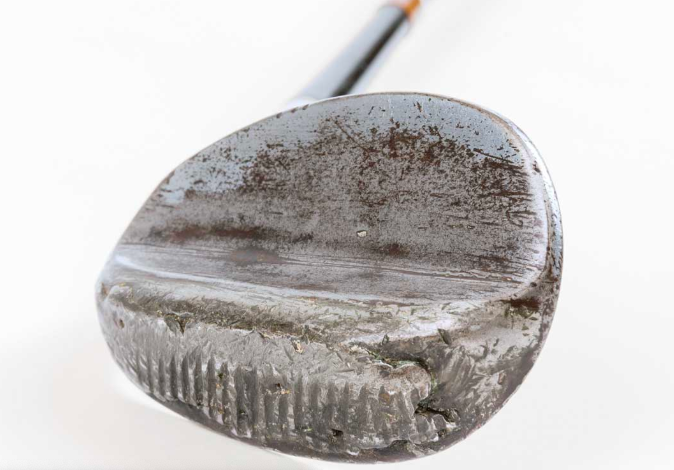







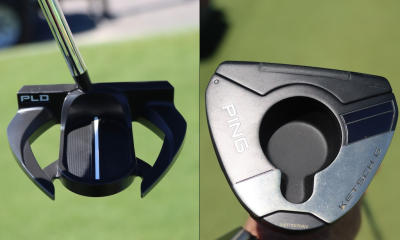















A. Young
Nov 4, 2023 at 11:41 pm
I had a Wilson R90 with the brown steel shaft growing up and totally agree. It was an awesome club. I still have a set of OG Cleveland 588’s from the tour van. I bought some new old stock heads that Cleveland made for the pros in preparation for the new groove rule. They’re the OG 588’s but with Tour Zip Grooves. I have had tour issue Vokey’s, Vokey TVD’s etc and nothing compares to the forged 588’s.
Buckeye
Sep 14, 2019 at 7:56 am
MacGregor “Dual Purpose” in the 50s-60s, with a groove in the center of the sole. You have to be of a certain age to have experienced it. And perhaps from Ohio. I’m sure Nicklaus would have had one.
slypanther
Sep 9, 2019 at 5:58 pm
The announcers are ill informed of the history of golf club technology, the audio is C**P, I would rather read the content as I do not have an hour of time in a day to just sit down and try to understand the commentators. I view WRX less and less as you have forced the majority of new content onto these podcasts. If I do not see a shift back to print media, soon, I will cancel my subscription status and look to Golf Digest/Monthly/World for info I desire about the golf industry
Dan W
Sep 2, 2019 at 8:37 am
Growing up, all “players” either had an eye 2 or the 588 and usually accompanied with mizuno blades, eye 2 irons, or DCI 762. The small tour prefereed TM woods, a copper anser or zing 2 putter and the loose bodied Ping bag with legs.
My bag in high school:
Tm tour preferred burner 7.5 and 15 deg
Ping eye 2 beCu 2-pw
588 56 deg
Copper ping zing 2 putter
That ping bag.
Saddle foot joy with old school metal spinks
Tour edition ball.
Just typing this up gives me a thick fat nostalga sandwich to chew on. Good times. I would love to recreate the whole set, ball included and go play onc last time with them.
Tim Armington
Sep 4, 2019 at 10:06 pm
You just described me!!!!
Dan W
Sep 8, 2019 at 2:21 am
Unbelievable, my bag was exactly the same but originally I had the copper 588, then the RTG. Dynamic Gold s-300 in the woods. Pings had zz lites and were black dot bent by ping from orange because they were hand me downs from my short grandpa. Found the putter broken in half in the garbage can in front of the pro shop. Soaked it in coke , reshafted it with an x-100 wedge shaft and loads of lead tape on the bottom. Top 2 putters I ever used. I still can’t figure out how the Tour editon could spin like it did with the firm cover it had. Also for a while I wore Mizuno shoes with permanent ceramic spikes until one popped out of the shoe. Saddle FG shoes were always a no brainer. Thanks for the trip down memory lane.
E. Tench
Nov 14, 2019 at 2:19 pm
Eye 2 sand and loft wedges, mizuno mp-32 irons, Zing 2 putter, Ping Hoofer bag. Loved the Tour Edition balls, they were like throwing darts. The mp-32s replaced Eye 2’s which replaced Eyes. Arizona born and raised, if you didnt have Eye 2’s you were saving up for them. Great post, thanks.
rex 235
Aug 31, 2019 at 5:13 pm
How could anyone ignore placing the Wilson Staff Dynapower Wedge series- 1957-1975 in the top 5?
steve
Sep 9, 2019 at 11:07 am
If this lists does not include the WS wedges and or joe powell JP wedges than don’t bother taking this serious,
ChipNRun
Aug 31, 2019 at 4:01 pm
Callaway Forged+ and XForged SW with C-grind stayed in golf bags for a long time; most got bumped out for competitive golfers who had to obey the 2010 grooves rule revision.
https://www.callawaygolfpreowned.com/golf-clubs/wedges/wedges-x-forged-2008.html?cgid=wedges
Webster Miller
Aug 28, 2019 at 5:00 pm
I’ve still got a BeCu R90 in the garage somewhere. That thing can dig divots like a backhoe. While the 588 is easily more popular, I always preferred the 485 for its smaller head. FWIW, there are 2 completely different 485 head shapes; one that is offset with a super wide sole, and then one that’s more traditional. The offset one is a chipping machine as you can just aim slightly behind the ball and let that wide sole due all the work.
Larry
Aug 25, 2019 at 6:33 pm
No Wilson 58 Dynapower????
James Awad
Aug 25, 2019 at 12:33 pm
No serious ‘top 10’ – never the less top 5 – list can POSSIBLY exclude the Hogan Sure Out.
But by all means, put Cameron’s poor cousin Vokey & his standard issue copies of stuff – made out of crushed up Yugos & tin cans.
Hack!
Darryl Souness
Aug 26, 2019 at 2:51 am
Crushed Yugos…. immense, I’ll borrow that if I may James.
duke
Aug 25, 2019 at 11:06 am
My all time favorite is the 588. I still have one in the bag.
Pelling
Aug 24, 2019 at 10:52 pm
The Cleveland VAS 792 PW clearly the most beautiful club ever made…
HDTVMAN
Aug 24, 2019 at 10:47 pm
I had Ping Eye2 56° & 60° in the 80’s, and the lob allowed me to do perfect flop shots. Just bought the new 54° & 58° Ping 3.0 Glide Eye2’s this weekend…can’t wait to try them Monday!
D
Aug 24, 2019 at 9:23 pm
Eye2 plus? The original square groove is the relevant club for this conversation. The plus was NOT well received.
Jamie
Aug 25, 2019 at 10:19 am
This.
Ed
Aug 25, 2019 at 5:15 pm
I agree. I thought for sure the original Eye 2 sand/lob wedges, which spawned all of the “high toe” wedges, would be the style profiled. Those are the best wedges I have ever used around the green.
Ditto
Aug 28, 2019 at 1:14 pm
The Eye 2 sole was FAR SUPERIOR to the Eye 2+ sole. The Eye 2+ Sole grind was horrible for the average player. Even Tour Pros favored the Eye 2 sole.
Bob
Aug 24, 2019 at 7:58 pm
Hogan Sure Out was very popular, late 70’s early 80’s
Tom54
Aug 24, 2019 at 6:48 pm
Anyone remember the Ram 3D wedge? Not sure if it was a pro model but it sure had a neat split sole design
RAR
Aug 24, 2019 at 5:50 pm
I think someone overlooked the Wilson R-20, it was one of the first sand wedges to ‘copy’ Sarazen
Andrew Millar
Aug 24, 2019 at 5:23 pm
Taylormade RAC TP
AF
Aug 24, 2019 at 2:44 pm
SCOR changed the Wedge category with the V-Sole (double bounce) & weight higher up the back.. More importantly, making the case forever that cavity back wedges are counter productive at best.. As far as I’m concerned, any Iron 40 degrees & up should never have any cavity..
I wish they had never been wiped away by Hogan..
D
Aug 24, 2019 at 7:34 pm
Scor wedges didn’t change anything. Crappy grind for 90%
Mark M
Aug 24, 2019 at 10:54 pm
Still playing SCOR wedges, best wedge I’ve ever used. But they’re getting very hard to find now.
Jonathan Weaver
Sep 2, 2019 at 8:59 am
wasnt scor a copy of the eidolon which was a copy of the Reid Lockhart?
Mario B
Aug 24, 2019 at 1:48 pm
Mizuno Raw Haze, Taylormade EF, Crews wedges
Howard Clark
Aug 24, 2019 at 1:45 pm
Hogan Special: best then; best now.
Mark
Aug 24, 2019 at 1:00 pm
Watson cobalt wedges were the ultimate wedges. Should have made this list.
L.T. White
Aug 24, 2019 at 10:17 am
Spaulding bird back wedges from 50’s and 60’s
Greg Templeton
Aug 24, 2019 at 2:24 am
Think the 588 released in 1988 had a shiny chrome finish until about 1996 when the Rad Tour Grind finish was offered as an option.
Techvan4Life
Aug 23, 2019 at 11:06 pm
You are wrong about the cleveland wedge naming system ending at the 588. The 691 was wedge 6 in 1991 the 797 beni was number 7 in 1997. Number 8 never made to market and the 900 was number 9 in 2000.
Then the system just got simple. Cg10, 11, 12, 14, 15, 16
Dennis Beach
Dec 5, 2022 at 11:30 pm
I had a set of 900’s,before my CBX2’s. Great wedges! Instant feedback, as they were forged.
Wedge Doctor
Aug 23, 2019 at 6:34 pm
Historically and impact fully, I’m not sure anyone could argue with:
1. The Sarazen Wedge
2. The Staff Dynapower Wedges
3. The Ping Eye 2 Square Groove
4. The Cleveland 588
5. The Vokey Spin Milled
Virtually everything else came as a result of those wedges.
Tim Vaughan
Aug 23, 2019 at 5:44 pm
Wilson staff dynapower 58-59, Nicklaus, Watson, chip in US Open Trevino and many more, should be Number 1
J Zilla
Aug 24, 2019 at 2:23 am
I don’t think mine is from 58-59 but a much later re-release, but I’ve had my Wilson Fluid-feel Dynapower since my earliest days golfing 30 years ago. I don’t play it anymore, but I always love taking it and looking at it. In fact I may even take it to the chipping green next time I go.
Bruce
Aug 23, 2019 at 3:28 pm
Console? Wilson Staff?
Darth Blader
Aug 23, 2019 at 3:08 pm
CG14?
Joe McManuis
Aug 23, 2019 at 3:06 pm
If not top 5 the Hogan Sure-out has to be # 6
Bob Jones
Aug 24, 2019 at 3:04 pm
Yes. From the bunker or the fairway it works great. And from tall grass, all that metal will not be denied.
tom
Aug 23, 2019 at 3:01 pm
Eye 2+ over Eye 2 square groove?????????????????????????????????????????????
Joe
Aug 24, 2019 at 4:00 pm
That’s what I was thinking. The non+ are the ones I’ve always liked (and have in my bag).
JB
Aug 23, 2019 at 2:40 pm
Can’t believe the replaceable face TaylorMade wedge didn’t make the list… lol
Scratchscorer
Aug 23, 2019 at 8:38 pm
lmao